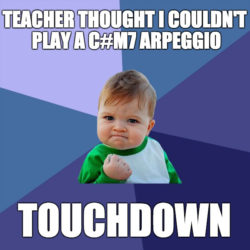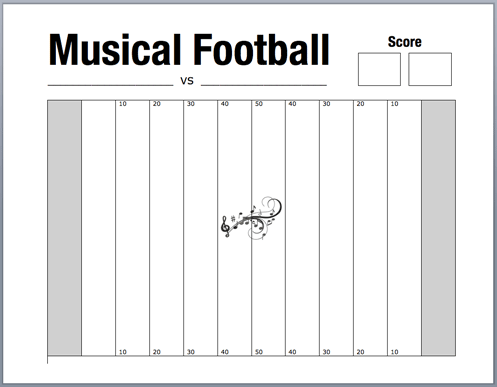Thrill your young students with Musical Football

Check out my Facebook Live demonstration of this game here.
I discovered my all-time favorite educational game for kids while flailing. I claim to specialize in teaching kids, but I have never felt like a natural. Still, shoot enough bullets in oil country, and eventually, up from the ground comes-a bubblin' crude.
I struck it rich with this one. Musical football is so fun, kids who normally watch the clock are crestfallen when their lesson ends. It even energizes the ones who're only there because they parents bribe them with screen time (yes, I have those students too). You will be blown away by how focused an ADD 8-year-old can be when a touchdown is on the line.
The game also works with kids who are oblivious to football, like my 7 y/o student Mila. Her Princesses always destroy my Rock Climbers. I love the visual.
Why football? I made the game to inspire a stick-in-the-mud 7-year-old boy obsessed with his dad's hometown team, the New York Giants. "If only John could learn guitar by watching football," I told myself after a particularly dreary lesson. On the commute home, I devised a ridiculous mix of football and guitar lessons, and Musical Football was born.
The game is versatile enough to train a variety of musical skills on any instrument. And it's so simple it can easily be adapted to many other sports or activities a child might like. All it does is repackage the exercises you'd normally do with your student.
Instructions
This game can easily be adapted to other sports, but let's assume we're playing football (American football, that is). If you don't know the rules, you should be able to get the gist of the game by reading the instructions, and then I'll teach you to modify the game for a sport or activity you're more familiar with.
Materials
1. A pen or pencil
2. A piece of paper representing an aerial view of a football field, like so:
Want to print this field? Download my free Musical Football Kit.
Setting up the Field
1. Choose team names, either real or made-up.
2. Write the team names above the field and in the end zones.
How to Play
The object of the game is for the student's team to progress across the football field from their 20 yard line into their end zone, earning them 7 points per touchdown. Progress is made by successfully performing musical challenges chosen by the teacher. When the teacher's team has the ball, the student's performance determines how well they play defense.
Steps
1. Write and circle a number "1" on your student's 20 yard line. This marks the ball's location on first down.
2. Ask the student to choose an short, medium, or long play. This determines how difficult their musical challenge will be, and how many yards they'll progress if they succeed.
3. Give the student a musical challenge. Any demonstration of skill that can be judged "right" or "wrong" will work.
4. Verbally dramatize the play based on their performance, as if you were a sports announcer.
5. Draw a line up field to show how far they progressed. Where the ball stops, write and circle a number "2" meaning it's now second down.
6. Repeat from step two until the student runs out of downs or gets a touchdown.
Need a visual? I did a demo of this game on Facebook Live here.
Turnovers
When the teacher's team has possession, the process is the same, except that you, the teacher, choose how difficult your play will be (since you now have the ball). You still choose a musical challenge for the student (that's what makes the game educational, right?), but now the student's performance determines how well they defend against your play. A shaky performance means the teacher's team successfully moves up the field, while a solid performance might result in an incomplete pass or a sack.
Duration and Winning
The game works best played over at least several 15-30 minutes sessions. I like to play it during the second half of my hour-long lessons, when young students would otherwise start to droop. Some of my guitar football games have been running for over a year.
Play until the student is 14 points ahead of you, or just use your discretion. I wait until the field gets torn, or starts to look like a Jackson Pollock painting. Then I give the student a heads-up that the clock is running down, and then wait for a climactic play, after which the final buzzer sounds.
Making it Fun
There are three keys to making this game fun:
1. Creating excitement by "calling the play" in a dramatic way. It really helps to be familiar with the sport or activity so that you can improvise a rich, realistic story.
2. Choosing musical challenges of the right difficulty. Short plays should be a non-threatening opportunity for the student to build confidence. Long plays should be challenging, but depending on the student's level of experience, confidence, and motivation, you may still want to choose a challenge that is well within their abilities. If I see them getting demoralized, I give them some easy challenges to restore their confidence.
3. Letting them win. I recommend that your students take the lead early on, and stay ahead. It's more fun and motivating that way. Save the grit-building lessons for the real ball field.
Making it Educational
It's fun to teach students party-trick skills like guitar harmonics, or a trill on the piano, or how to make a trumpet sound like an elephant. I introduce students to the game with these challenges to get them hooked. But once they are, bring more academic rigor to this game by aligning your musical challenges with your goals for your student. If they're working on a song for example, their musical challenges can simply be exercises you'd normally give them to learn the piece.
Tips
1. If the student is unfamiliar with the rules of football, be very brief and simple when explaining them. Use the term "try" instead of "down," i.e. "You get four tries to go this far."
2. Focus on creating drama and giving the student a sense of accomplishment. For most students, this is more interesting than the mechanics of foodball.
3. That said, if both of you are football experts, it can be fun to add complexity to the game to allow for more strategy: Field goals, punting, interceptions and fumbles, etc.
4. When appropriate, give the student time to practice their musical challenge before their final attempt. And if they still struggle, and I think some more info would help, I suggest they take a "time out," where I pretend to be their coach giving them some sage advice on how to succeed.
5. At the end of the lesson, I label the dot where we left off with the date so that we can find it next time we play.
Adapting the Game to Other Sports
Musical football can easily be adapted to your student's favorite sport. This can give a huge boost to your student-teacher bond. You know how it feels when a friend gets you the perfect gift? You can give your young student the same sense of being appreciated and understood.
Any sport or activity will work as long as it involves reaching a specific location. In soccer (i.e. real football) you move a ball downfield into a goal. In baseball or kickball, you move around the bases. In Mario Kart (yes, computer games work too), you fly down a race track toward the finish line. Tennis, however, doesn't translate as well, because there isn't a clearly defined destination for the ball (or the players).
FYI, Musical Football usually lasts longer than, say, Musical Soccer or Musical Pole Vaulting, because of how many plays it typically takes to score any points (and even then, the teacher's team gets the ball and the game continues).
What Gets Changed
Come up with an activity that the player must do four times to reach their destination: Four kicks to get the soccer ball in the goal, four tanks of gas to reach the finish line, etc. If they don't reach their goal in four tries, the consequence should match the sport: The other soccer team gets the ball, the race car explodes, the exhausted mountain climber trying to scale K2 tumbles into a crevasse. Who knew oboe lessons could be so thrilling?
Instead of a football field, draw an aerial view of the area of play on paper--the field, racetrack, mountain, etc.--with the starting point at one end, and the goal at the other.
What Stays the Same
No matter the sport, give the student options to choose short, medium, or long attempts. And set a limit on the number of attempts they can make before they reach their goal, like the "downs" of American football. Four attempts work well.
And as always, the student should win in the end. So when their car bursts into flames, they get a new one to drive the rest of the way to the finish line. The ghost of the mountaineer floats back up to her high point to swing her spectral ice axe again. Thus, failure is just a little speedbump on the road to victory.
Print and Commit
While it's on your mind, download my Musical Football Kit and print it out, and choose one student to play the game with this next week.
Any questions before you try the game? Leave them below!
Have fun!

